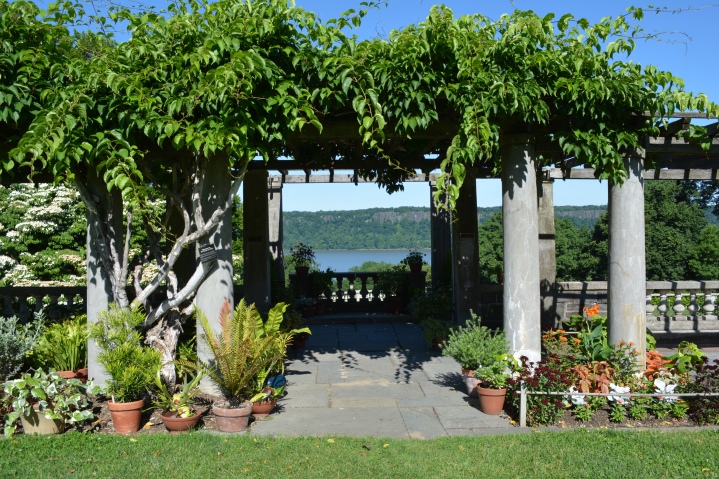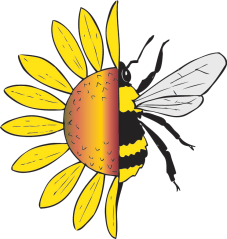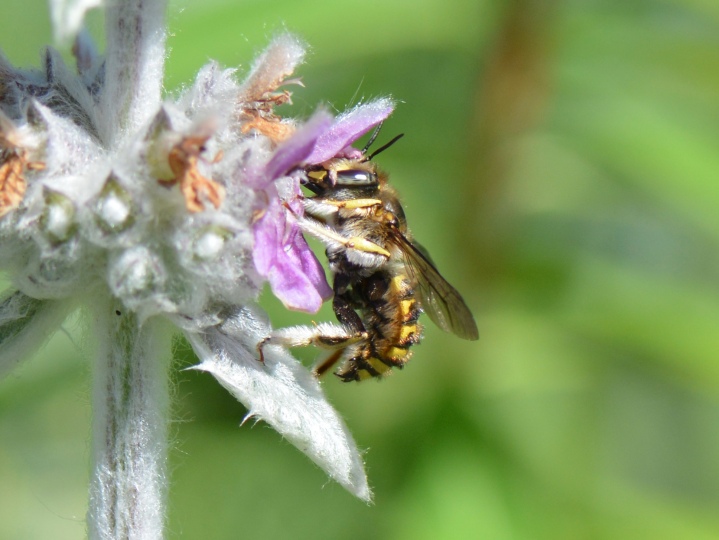Wave Hill in the Bronx is a 28 acre garden, an oasis that transports visitors to another world. The vista from the Pergola Overlook commands the attention of the Palisades, sheer cliffs that rise from the western shore of the Hudson River. The gardens form a pollinator haven amid an urban landscape. There is mounting evidence that planting flower patches in urban gardens and green spaces can help restore bee populations threatened by habitat loss, pesticides, and climate change. Evidence resides in these gardens that entice visitors to take a closer look at the diversity of pollinators including a variety of native bees, butterflies and even introduced exotic bee species. This is a dynamic landscape with insects living out their lives among the flowers that sustain and nurture future generations.

Pergola Overlook with View of Palisades. This also is an ideal nesting site for the Large Carpenter Bees (Xlocopa spp.)
In 2008 a study conducted in community gardens in highly urbanized areas of the Bronx and East Harlem found 54 species or 13% of the bee species found in New York State (450 plus species live throughout the state). Bees that nest in cavities, hives, woody pith and rotting wood were found in higher numbers than soil nesting bees. This makes sense in an urban landscape covered in pavement and cement. The Flower Garden at Wave Hill provides suitable habitat for ground nesting bees such as cellophane bees (Colletes spp.) that can be found making their nests among the flower roots. Solitary bees are pacifists and should never be confused with aggressive ground nesting yellow jackets, a type of wasp. Solitary bees have no queen to protect but rather each female silently goes about her business of laying eggs to ensure a new generation of bees will emerge. 70% of all native pollen bees nest in underground tunnels and it is an important consideration in urban landscapes to provide the necessary habitat to welcome these them.
The same study found of the 54 bee species, exotic bee species were abundant and represented 19% of the total species recorded. In fact, casual observations at the Wave Hill gardens support this finding. Non-native carder bees can be found in large numbers hovering among the lambs ear and beard tongue flowers. Carder bees are stout bees with distinct yellow markings and make their nests in hollow tubed cavities. The males are territorial and aggressively defend a “bee free” zone. The males do not have stingers but five spikes on their abdomens that can cause serious injury to any bumble bee (an honey bees) that try to enter its domain. Most native bees, like bumble bees practice floral constancy, meaning they visit one type of flower at a time, this practice increases a flowers odds to successful pollination. Carder bees do not practice floral constancy and have a reputation of bouncing around among species of flowers, making them less effective pollinators. The long term impact of carder bees is a matter of future studies.
New York City is home to people from around the world planting a diversity of plants from across the globe. This can be beneficial to generalist pollinators that have no particular floral preference but not so beneficial for specialist pollinators. 30% of native bees actually specialize on individual species or groups of flowers within the same family. At the YMCA Kingston Farm Project garden ground cherries and tomatillos growing attract the bee specialist called the broad footed cellophane bee (Colletes latitarsis). Kingston, NY is a small city that is home to a native ground nesting bee. Planting native flowers for bee specialists has been identified as a top priority in garden planning. The Elliptical Garden at Wave Hill is also a native plant garden and the Wild Garden with meandering trails has numerous native plants that entice a variety of native bees including blue mason bees (Osmia spp.) that collect pollen on the underside of their bellies (abdomen). Some Osmia species specialize on flowers in the rose family which include most fruit trees.
A highlight of a mid-June day at Wave Hill is the small leafed linden (Tilia cordata) that sits out front of the Wave Hill House. This popular nectar producing tree when in bloom is a pollinator magnet, with branches reaching to the ground, its easy to find bumble bees, carpenter bees, honey bees and mining bees all drunk on the nectar. As with most trees, it seems the bees are drawn upward to the higher branches where in unison they form a low and steady buzz. Basswood is the little leafed lindens American cousin and the sugar content of the nectar is reported to be as high as 33%. These trees though they bloom for a short time, are a pollinator favorite.

The Little Leaf Linden attracts lots of pollinators. It’s American cousin Basswood is equally prized by pollinators.
Sitting in the summer shade at Wave Hill its easy to imagine that cities may be the new frontier in increasing pollinator diversity. Plant it and they will come! Wave Hill is one of many interconnected parks that provide pollinators with the resources they need to raise their next generation. The 50 acre forested Riverdale Park adjacent to Wave Hill stretches south almost to the 200 acre Inwood Hill Park in northern Manhattan. Inwood Hill is a remnant wild section of the island that sits just north of the 66 acre Fort Tyron Park. It is more than a summers dream that urban gardens and green spaces, with proper planning can help restore bee populations threatened by habitat loss, pesticides, and climate change change. It’s almost unbelievable that something as small as a bee can motivate people to create positive change in the world.

Variety of Pollinators found at Wave Hill. Top left: Sweat Bee (Halictus spp.), Top right: Bumble bee (Bombus spp.), Bottom Right: Small Sweat Bee (Lassioglossum spp.) Bottom Left: Silver Spotted Skipper
References:
Bee Richness and Abundance in New York City Urban Gardens
Kevin C. Matteson, John S. Ascher, and Gail A. Langellotto
Annals of the Entomological Society of America Jan 2008 : Vol. 101, Issue 1, pg(s) 140- 150
The City as a Refuge for Insect Pollinators
Damon M. Hall Gerardo R. Camilo Rebecca K. Tonietto Jeff Ollerton Karin Ahrné Mike Arduser John S. Ascher Katherine C. R. Baldock Robert Fowler Gordon Frankie Dave Goulson Bengt Gunnarsson Mick E. Hanley Janet I. Jackson Gail Langellotto David Lowenstein Emily S. Minor Stacy M. Philpott Simon G. Potts Muzafar H. Sirohi Edward M. Spevak Graham N. Stone Caragh G. Threlfall
Conservation Biology February 2017 : Vol 31, Issue 1, pg(s) 24-29






